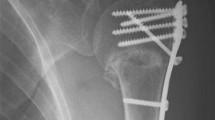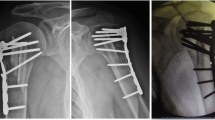Abstract
Objective
To evaluate the shoulder function and shoulder girdle muscle strength of humeral diaphysis fractures postoperatively following intramedullary nailing (IMN) and open reduction internal fixation (ORIF).
Methods
Fifty cases of humeral diaphysis fractures were randomly allocated into two groups. Antegrade IMN and ORIF were, respectively, performed in group I and II. Union status, functional scoring, range of motion, muscle strength of shoulder girdle including external/internal rotation and abduction/adduction strength were recorded at 18 months after surgery. Statistical package for social sciences 13.0 was used for analysis.
Results
Group I had lower functional score than group II (P < 0.05). Both groups had approximately 50 % of muscle strength loss on injured side. In group II, the internal rotation strength loss was significantly greater compared to group I (P < 0.01). The total side to side (internal plus external) range of rotation (ROR) lack and external ROR lack of involved shoulder was significantly greater in group I (P = 0.005 and 0.049). The range of abduction lack was also significantly greater in group I.
Conclusions
Both surgically treated groups had significant loss of muscle strength of shoulder girdle when measured at 18 months postoperatively. There was greater loss of rotation strength in ORIF group than the IMN group. However, IMN had lower functional scores and a decreased range of motion postoperatively. The assumption that rotator cuff damage caused by nailing leads to weaker abduction strength than plating was not supported.





Similar content being viewed by others
References
Denard A Jr, Richards JE, Obremskey WT, Tucker MC, Floyd M, Herzog GA (2010) Outcome of nonoperative vs. operative treatment of humeral shaft fractures: a retrospective study of 213 patients. Orthopedics 33(8):552–557
Carroll EA, Schweppe M, Langfitt M, Miller AN, Halvorson JJ (2012) Management of humeral shaft fractures. J Am Acad Orthop Surg 20:423–433
Mahabier KC, Vogels LM, Punt BJ, Roukema GR, Patka P, Van Lieshout EM (2012) Humeral shaft fractures: Retrospective results of non-operative and operative treatment of 186 patients. Injury 44(4):427–430
Huttunen TT, Kannus P, Lepola V, Pihlajamaki H, Mattila VM (2012) Surgical treatment of humeral-shaft fractures: a register-based study in Finland between 1987 and 2009. Injury 43:1704–1708
Mulier T, Seligson D, Sioen W, van den Bergh J, Reynaert P (1997) Operative treatment of humeral shaft fractures. Acta Orthop Belg 63(3):170–177
Concha JM, Sandoval A, Streubel PN (2010) Minimally invasive plate osteosynthesis for humeral shaft fractures: are results reproducible. Int Orthop 34:1297–1305
Shin SJ, Sohn HS, Do NH (2012) Minimally invasive plate osteosynthesis of humeral shaft fractures: a technique to aid fracture reduction and minimize complications. J Orthop Trauma 26:585–589
Chapman JR, Henley MB, Agel J, Benca PJ (2000) Randomized prospective study of humeral shaft fracture fixation: intramedullary nails versus plates. J Orthop Trauma 14(3):162–166
Ajmal M, O’Sullivan M, McCabe J, Curtin W (2001) Antegrade locked intramedullary nailing in humeral shaft fractures. Injury 32(9):692–694
Bhandari M, Devereaux PJ, McKee MD, Schemitsch EH (2006) Compression plating versus intramedullary nailing of humeral shaft fractures—a meta-analysis. Acta Orthop 77(2):279–284
Cox MA, Dolan M, Synnott K, McElwain JP (2000) Closed interlocking nailing of humeral shaft fractures with the Russell-Taylor nail. J Orthop Trauma 14(5):349–353
Changulani M, Jain UK, Keswani T (2007) Comparison of the use of the humerus intramedullary nail and dynamic compression plate for the management of diaphyseal fractures of the humerus. A randomised controlled study. Int Orthop 31(3):391–395
Daglar B, Delialioglu OM, Tasbas BA, Bayrakci K, Agar M, Gunel U (2007) Comparison of plate-screw fixation and intramedullary fixation with inflatable nails in the treatment of acute humeral shaft fractures. Acta Orthop Traumatol Turc 41(1):7–14
Putti AB, Uppin RB, Putti BB (2009) Locked intramedullary nailing versus dynamic compression plating for humeral shaft fractures. J Orthop Surg (Hong Kong) 17(2):139–141
Golebiewska JA, Mastalerz A, Zielinski JR (2008) Isokinetic muscle torque during glenohumeral rotation in dominant and nondominant limbs. Acta Bioeng Biomech 10(2):69–73
Broadbent MR, Will E, McQueen MM (2009) Prediction of outcome after humeral diaphyseal fracture. Injury 41(6):572–577
Gierer P, Scholz M, Beck M, Schaser KD, Vollmar B, Mittlmeier T, Gradl G (2010) Microcirculatory sequelae of the rotator cuff after antegrade nailing in proximal humerus fracture. Arch Orthop Trauma Surg 130(5):687–691 (Epub 2009 Aug 13)
Flinkkila T, Hyvonen P, Siira P, Hamalainen M (2004) Recovery of shoulder joint function after humeral shaft fracture: a comparative study between antegrade intramedullary nailing and plate fixation. Arch Orthop Trauma Surg 124(8):537–541
Li Y, Wang C, Wang M, Huang L, Huang Q (2011) Postoperative malrotation of humeral shaft fracture after plating compared with intramedullary nailing. J Shoulder Elbow Surg 20(6):947–954
Fjalestad T, Stromsoe K, Salvesen P, Rostad B (2000) Functional results of braced humeral diaphyseal fractures: why do 38% lose external rotation of the shoulder. Arch Orthop Trauma Surg 120:281–285
Conflict of interest
We announce that no financial support was received from any companies or manufactures for this study. All authors confirm that they have no financial and personal relationships with other people or organizations that could inappropriately influence (bias) this work, during the 3 years since the beginning of the work submitted.
Ethical review committee statement
In accordance with the ethical standards in the 1964 Declaration of Helsinki, all relevant ethical safeguards have been met in relation to patient or subject protection with the authorization of institute’s ethical review committee.
Author information
Authors and Affiliations
Corresponding author
Additional information
C. Wang and G. Dai contributed to the research equally.
Rights and permissions
About this article
Cite this article
Wang, C., Dai, G., Wang, S. et al. The function and muscle strength recovery of shoulder after humeral diaphysis fracture following plating and intramedullary nailing. Arch Orthop Trauma Surg 133, 1089–1094 (2013). https://doi.org/10.1007/s00402-013-1768-8
Received:
Published:
Issue Date:
DOI: https://doi.org/10.1007/s00402-013-1768-8




